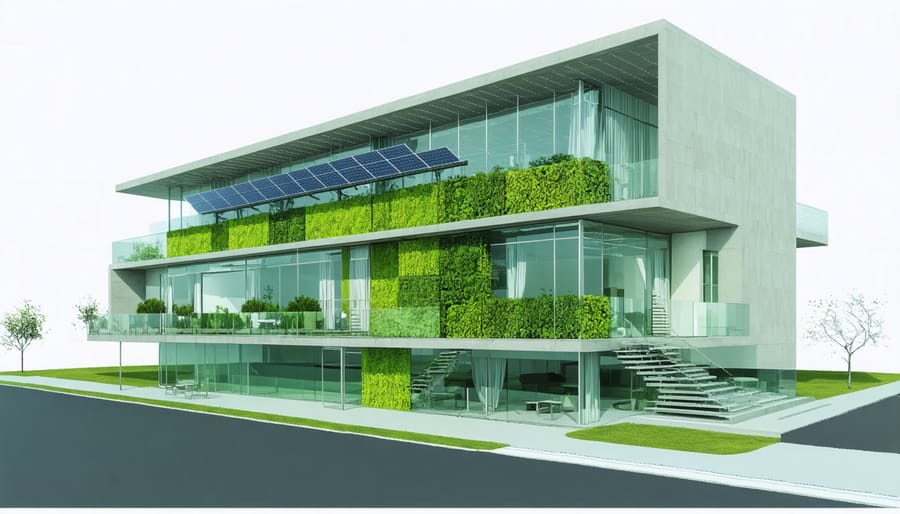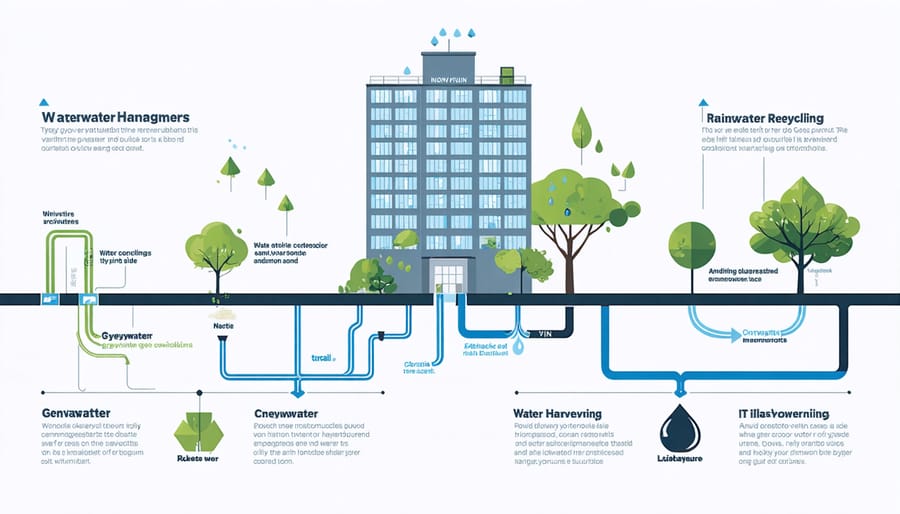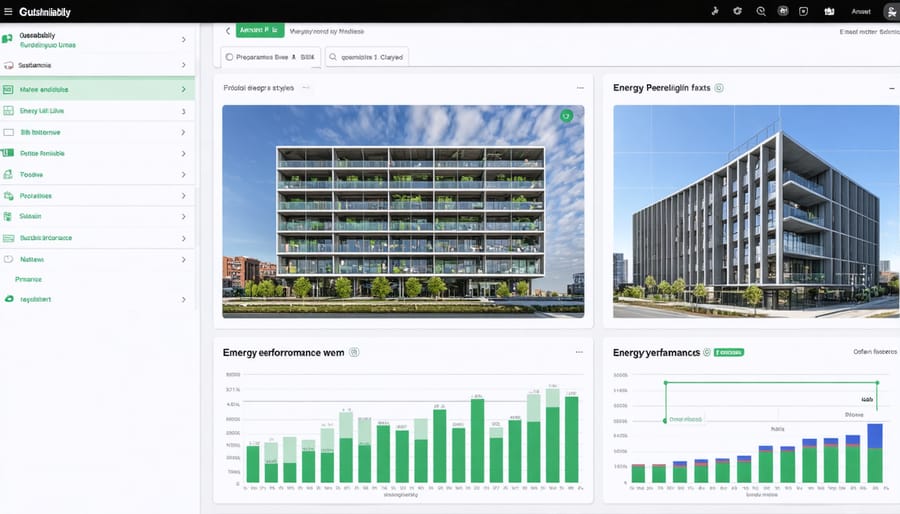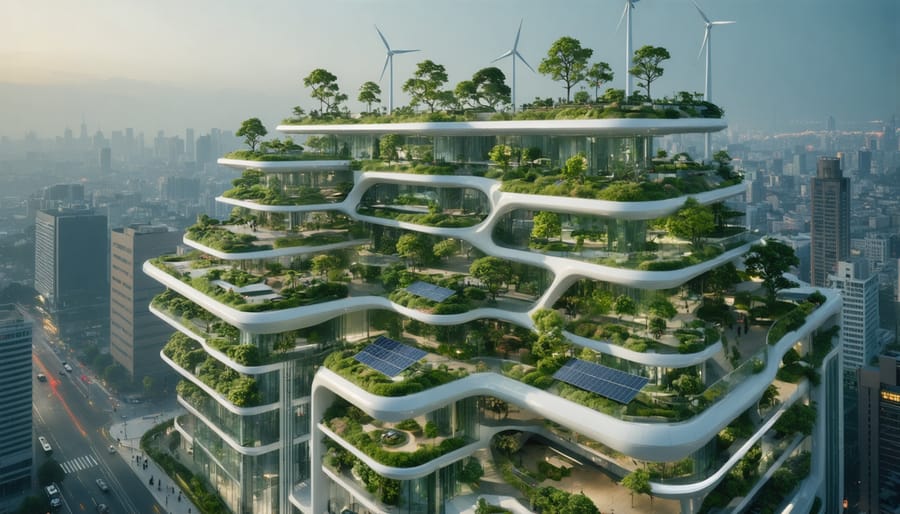Transforming the construction industry demands a fundamental shift toward sustainable practices that balance environmental stewardship with economic viability. As global resources become increasingly scarce and climate change accelerates, the imperative for sustainable design and construction has evolved from an optional consideration to a critical business imperative. Industry leaders are pioneering innovative approaches that merge cutting-edge technology with time-tested ecological principles, reducing environmental impact while enhancing building performance and occupant well-being.
The integration of sustainable practices throughout the project lifecycle—from initial design conceptualization through construction and ongoing operations—represents a paradigm shift in how we approach the built environment. This comprehensive approach encompasses materials selection, energy efficiency, waste reduction, and resource conservation, while considering the long-term implications for both environmental and human health. Forward-thinking organizations are discovering that sustainable construction not only minimizes ecological footprint but also delivers compelling financial returns through reduced operating costs and increased asset value.
As we stand at the intersection of environmental responsibility and technological advancement, the construction industry faces unprecedented opportunities to redefine building practices for future generations. This transformation requires collaboration across disciplines, innovative thinking, and a commitment to measurable sustainability goals that extend beyond traditional metrics of success.
The Evolution of Sustainable Building Materials
Bio-Based Building Materials
Bio-based building materials represent a significant advancement in sustainable construction, offering renewable alternatives to traditional materials while maintaining structural integrity and performance. Bamboo has emerged as a particularly promising material, with tensile strength comparable to steel and a rapid growth cycle of just 3-5 years. Its versatility allows for applications ranging from structural elements to interior finishes, while its carbon sequestration properties make it environmentally beneficial.
Mycelium-based materials are revolutionizing the industry through their innovative approach to construction. These fungal-derived composites can be grown into specific shapes and sizes, offering excellent insulation properties and fire resistance. When properly treated, mycelium materials demonstrate remarkable durability and can significantly reduce a building’s carbon footprint.
Recycled composites, including materials made from agricultural waste and post-consumer products, are gaining traction in commercial construction. For instance, wheat straw panels provide robust alternatives to traditional drywall, while recycled plastic lumber offers weather-resistant solutions for exterior applications. These materials not only divert waste from landfills but often outperform conventional options in terms of durability and maintenance requirements.
Recent advancements in bio-based adhesives and treatments have enhanced the performance of these materials, addressing historical concerns about longevity and weather resistance. Construction professionals are increasingly incorporating these sustainable alternatives into their projects, driven by both environmental considerations and improving cost-effectiveness.

Smart Material Technologies
Smart materials represent a significant leap forward in construction industry innovations, offering unprecedented capabilities in sustainability and building performance. Self-healing concrete, incorporating bacterial spores that activate when cracks form, can autonomously repair damage, extending structural lifespan and reducing maintenance requirements. This technology has shown promising results in field trials, with some specimens demonstrating complete crack healing within 28 days.
Phase-change materials (PCMs) are revolutionizing thermal management in buildings. These materials can absorb, store, and release large amounts of energy during phase transitions, effectively regulating indoor temperatures and reducing HVAC energy consumption by up to 30%. Implementation strategies include PCM-enhanced wallboards and concrete mixtures.
Other notable innovations include photocatalytic materials that actively break down air pollutants, and electrochromic glass that automatically adjusts its tint based on sunlight intensity. Shape-memory alloys are being integrated into structural systems for enhanced seismic resistance, while carbon-absorbing concrete formulations actively sequester CO2 during their lifetime.
These advanced materials not only improve building performance but also contribute significantly to reducing environmental impact. Early adoption data suggests that buildings incorporating smart materials can achieve 25-40% better energy efficiency compared to conventional structures, while substantially reducing maintenance costs over their lifecycle.

Energy-Efficient Design Strategies
Passive Design Solutions
Passive design solutions represent a cornerstone of sustainable construction, leveraging natural elements and architectural principles to reduce energy consumption and enhance occupant comfort. These strategies, when implemented during the early design phase, can significantly decrease a building’s environmental impact while optimizing operational costs.
Natural lighting, or daylighting, serves as a primary passive design element. Strategic placement of windows, skylights, and light wells maximizes sunlight penetration while minimizing glare and heat gain. Light shelves and reflective surfaces can extend daylight penetration up to 2.5 times deeper into building interiors, reducing artificial lighting requirements by up to 80%.
Natural ventilation systems utilize building orientation, window placement, and stack effect principles to maintain optimal indoor air quality and thermal comfort. Cross-ventilation strategies, when properly designed, can reduce cooling energy demands by 50-75% in appropriate climates. Advanced features like solar chimneys and wind catchers enhance these effects, particularly in commercial structures.
Thermal management techniques incorporate materials and design elements that regulate indoor temperatures naturally. Thermal mass materials, such as concrete and stone, absorb and release heat gradually, moderating temperature fluctuations. Strategic placement of shade structures, including extended eaves and vertical fins, prevents excessive solar gain during summer while allowing beneficial winter sun exposure.
Recent studies indicate that well-implemented passive design solutions can reduce HVAC energy consumption by 30-70%, depending on climate zone and building type. Building orientation alone can impact energy efficiency by up to 20%, highlighting the importance of early-stage passive design considerations. These solutions, when combined with modern building technologies, create resilient, energy-efficient structures that meet both environmental and economic objectives.
Active Energy Systems
The integration of active energy systems represents a cornerstone of modern sustainable construction, combining renewable energy technologies with intelligent building management systems. As demonstrated in recent energy-efficient commercial buildings, these systems maximize operational efficiency while minimizing environmental impact.
Solar photovoltaic arrays, wind turbines, and geothermal heat pumps form the foundation of renewable energy integration, while smart building technologies optimize their performance. Advanced Building Management Systems (BMS) utilize artificial intelligence and machine learning algorithms to analyze real-time data, adjusting energy consumption patterns based on occupancy, weather conditions, and peak demand periods.
Energy storage solutions, particularly lithium-ion batteries and thermal storage systems, play a crucial role in managing intermittent renewable energy sources. These systems store excess energy during peak production periods for use during high-demand times or when renewable sources are unavailable.
Smart metering and monitoring systems provide detailed insights into energy consumption patterns, enabling facility managers to identify inefficiencies and implement targeted improvements. Integration with IoT sensors and automated controls allows for precise management of HVAC systems, lighting, and equipment operation.
The implementation of microgrids further enhances energy resilience, allowing buildings to operate independently from the main power grid when necessary. This capability ensures continuous operation during power outages while facilitating the integration of multiple renewable energy sources.
Recent innovations in building-integrated photovoltaics (BIPV) merge energy generation with architectural elements, transforming building envelopes into power-generating assets while maintaining aesthetic appeal. This dual functionality represents the future of sustainable building design, where energy systems become seamlessly integrated into the architectural fabric.

Water Conservation and Management
Rainwater Harvesting Systems
Modern rainwater harvesting systems have evolved into sophisticated solutions that integrate seamlessly with building infrastructure. These systems typically comprise collection surfaces (usually rooftops), conveyance mechanisms, first-flush diverters, storage tanks, and filtration units. Advanced systems now incorporate smart monitoring technology to track water quality, usage patterns, and system efficiency.
Commercial buildings can significantly reduce municipal water consumption by implementing properly designed harvesting systems. A typical system can capture approximately 600 gallons of water per 1,000 square feet of roof area for every inch of rainfall, making it a viable solution for sustainable water management.
Key components of modern systems include UV sterilization units, automated filtration systems, and pressure pumps for consistent water distribution. Integration with building management systems (BMS) allows for optimal utilization of harvested water for non-potable applications such as irrigation, toilet flushing, and HVAC cooling towers.
Recent innovations include modular storage solutions that can be expanded as needed, smart sensors for real-time monitoring, and hybrid systems that combine rainwater harvesting with greywater recycling for maximum efficiency. These advancements make rainwater harvesting an increasingly attractive option for sustainable building design.
Greywater Recycling Solutions
Greywater recycling systems represent a significant opportunity for commercial buildings to reduce their water footprint while achieving substantial cost savings. These systems capture and treat water from sinks, showers, and other non-toilet fixtures, making it suitable for non-potable applications such as irrigation, toilet flushing, and cooling tower makeup water.
Modern commercial implementations typically integrate dual-plumbing systems, allowing for separate collection and distribution networks. A standard system includes filtration units, disinfection modules, and storage tanks, with advanced monitoring systems ensuring water quality meets regulatory requirements. Studies indicate that properly implemented greywater systems can reduce a building’s water consumption by 30-50%.
Recent innovations in membrane technology and smart monitoring systems have made these solutions more efficient and cost-effective. For example, the Empire State Building’s retrofit greywater system saves approximately 4 million gallons annually. When designing these systems, engineers must consider factors such as peak demand, storage capacity, and treatment requirements specific to the intended end-use.
The return on investment typically ranges from 3-7 years, depending on local water rates and installation complexity. Regular maintenance and water quality testing are essential for optimal system performance and compliance with health regulations.
Digital Tools for Sustainable Construction
BIM for Sustainability
Building Information Modeling (BIM) has emerged as a pivotal tool in achieving sustainability goals within the construction industry. By creating detailed digital representations of buildings, BIM enables project teams to analyze and optimize environmental performance throughout the project lifecycle.
The integration of BIM with sustainability analysis tools allows designers to conduct comprehensive energy modeling, daylighting studies, and carbon footprint assessments during the early design phases. This capability enables real-time adjustments to building orientation, envelope design, and systems selection, maximizing energy efficiency before construction begins.
BIM’s material tracking and quantity takeoff features help teams make informed decisions about sustainable material selection and waste reduction. The platform can calculate embodied carbon, track recycled content percentages, and evaluate material lifecycle impacts, supporting environmentally conscious procurement decisions.
Advanced BIM applications now incorporate artificial intelligence to suggest optimal sustainable design solutions based on project parameters and performance targets. These systems can analyze thousands of design iterations to identify the most environmentally effective options while maintaining cost efficiency.
During construction, BIM facilitates precise prefabrication and assembly planning, reducing on-site waste and improving resource efficiency. The model continues to provide value through operations, enabling facilities managers to optimize building performance and maintain sustainable systems effectively.
Recent case studies demonstrate that BIM-enabled sustainable design can reduce energy consumption by up to 30% and construction waste by 15-20% compared to traditional methods. As sustainability requirements become more stringent, BIM’s role in achieving green building certifications and meeting environmental regulations becomes increasingly critical.

Performance Monitoring Systems
Performance monitoring systems play a crucial role in maintaining and optimizing sustainable buildings through real-time data collection and analysis. Modern building management systems (BMS) integrate various sensors and smart technologies to track key sustainability metrics, including energy consumption, water usage, indoor air quality, and occupant comfort levels.
These systems typically comprise a network of IoT sensors that continuously collect data from building systems such as HVAC, lighting, and water management. Advanced analytics platforms process this information to identify patterns, predict maintenance needs, and optimize resource consumption. For instance, smart meters can detect unusual energy usage patterns and automatically adjust systems to maintain optimal efficiency.
Building operators can monitor performance through comprehensive dashboards that display real-time data and historical trends. These interfaces often feature customizable alerts that notify facility managers when systems deviate from predetermined sustainability targets. Additionally, many platforms now incorporate artificial intelligence and machine learning capabilities to suggest operational improvements and automate system adjustments.
Leading sustainability tracking tools also facilitate compliance with green building certifications by automatically generating required documentation and performance reports. This integration streamlines the certification process while ensuring continuous adherence to sustainability standards. Some systems even benchmark building performance against similar facilities, providing valuable insights for improvement strategies.
Recent innovations include occupancy-based controls that automatically adjust building systems based on real-time usage patterns, significantly reducing unnecessary energy consumption while maintaining occupant comfort.
Case Studies: Success Stories in Sustainable Construction
The transformative impact of sustainable construction practices is best illustrated through real-world success stories that demonstrate both environmental and economic benefits. The Bullitt Center in Seattle stands as a prime example of net-zero energy achievement in commercial construction. Completed in 2013, this six-story structure generates 60% more energy than it consumes through a combination of solar panels, geothermal wells, and advanced building automation systems. The project’s 250-year design life challenges traditional building lifecycles while maintaining a competitive cost per square foot.
In Copenhagen, the UN City complex showcases how large-scale institutional buildings can achieve LEED Platinum certification. The star-shaped structure reduces energy consumption by 55% compared to similar buildings through innovative seawater cooling systems and dynamic solar shading. The project’s waste management system recycles 95% of construction materials, setting new benchmarks for resource efficiency.
The Edge building in Amsterdam demonstrates the integration of smart technology with sustainable design. Dubbed the “smartest building in the world” by Bloomberg, it achieves unprecedented levels of energy efficiency through 28,000 sensors that regulate lighting, temperature, and occupancy. The building’s energy-neutral operations have resulted in a 70% reduction in electricity costs while improving worker productivity and satisfaction.
In Melbourne, the Pixel Building proves that smaller-scale projects can achieve remarkable sustainability goals. This four-story office building generates all its water and energy on-site, featuring a vacuum toilet system that reduces water consumption by 90%. The structure’s innovative carbon-neutral concrete mixture reduced embodied energy by 65%, establishing new possibilities for sustainable materials in construction.
These case studies demonstrate that sustainable building practices not only benefit the environment but also deliver significant operational cost savings and enhanced occupant experiences. Their success has paved the way for broader adoption of green building technologies across the construction industry.
The construction industry stands at a pivotal moment in its evolution towards sustainability. Recent global sustainable development trends indicate a decisive shift toward carbon-neutral building practices, innovative material technologies, and intelligent design solutions. The integration of AI-driven design tools, advanced recycling technologies, and biophilic principles is expected to accelerate in the coming years. Industry leaders are increasingly recognizing that sustainable construction isn’t just an environmental imperative but a compelling business strategy. As regulations tighten and client demands evolve, we can expect to see broader adoption of green building certifications, renewable energy systems, and circular economy principles. The future of construction lies in balancing environmental responsibility with economic viability, creating buildings that not only minimize their ecological footprint but actively contribute to environmental regeneration and human wellbeing.

